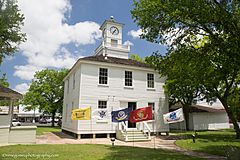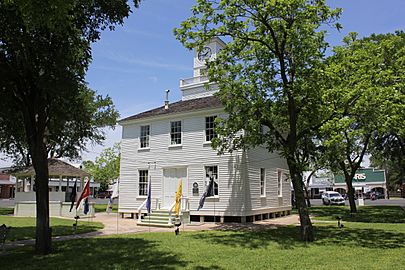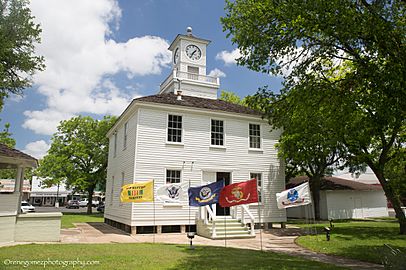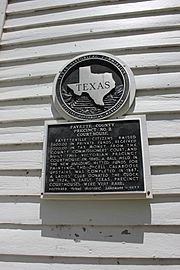Fayette County Precinct No. 2 Courthouse facts for kids
Quick facts for kids Fayette County Precinct No. 2 Courthouse |
|
|---|---|

Fayette County Precinct No. 2 Courthouse in 2019
|
|
| Location | Fayetteville, Texas |
| Built | 1880 |
| Original use | courthouse |
| Architectural style(s) | Victorian |
|
U.S. Historic district
Contributing property |
|
| Designated | 10 July 2008 |
| Part of | Fayetteville Historic District |
| Reference no. | 08000657 |
|
Recorded Texas Historic Landmark
|
|
| Designated | 1977 |
| Reference no. | 1580 |
| Lua error in Module:Location_map at line 420: attempt to index field 'wikibase' (a nil value). | |
The Fayette County Precinct No. 2 Courthouse is an old and important building in Fayetteville, Texas. It was once a place where local government business happened. Today, it stands as a reminder of the town's history.
Contents
A Look Inside This Historic Building
This building was constructed in 1880. It is made of wood with horizontal wooden planks on the outside. The building has two stories and a simple square shape.
Design and Features
The front of the building faces south. It has simple wooden stairs leading up to double doors made of solid wood. The windows are placed evenly on all sides. There are three windows on the north and south sides, and two on the east and west sides. The building is designed in the Victorian style, which was popular a long time ago.
How It Was Built
Building this courthouse cost US$600 (equivalent to $18,194 in 2022) from the people of Fayetteville. The County Commissioners' Court also added US$200 from tax money. To pay for painting the building, the community held a special dance!
Special Features and History
In 1887, a small jail, called a calaboose, was added. It had two cells for holding people. Later, in 1934, a clock tower was built in the middle of the roof. A group of ladies helped pay for this tower.
This building is no longer used as a courthouse. Buildings like this, called "precinct courthouses," were very rare in early Texas. Because of its history, it was named a Recorded Texas Historic Landmark in 1997. On July 10, 2008, it also became part of the Fayetteville Historic District. This means it's an important part of the historic area in Fayetteville.
Photo gallery




